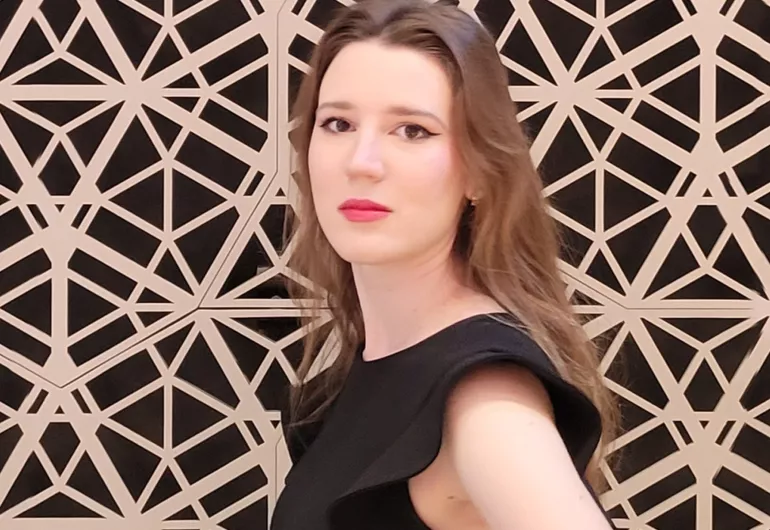May 2, 2023
Emily Renee Elizabeth Roth, Organ

Choral in A minor, FWV 40
César Franck (1822-1890)
Fantasy on ‘Ubi Caritas’
Brenda Portman (b. 1980)
Sonate II
Lebhaft
Ruhig bewegt
Fugue Mäßig bewegt, heiter
Paul Hindemith (1895-1963)
Dieu est Simple from Méditations sur le Mystère de la Sainte Trinité
Olivier Messiaen (1908-1922)
Clair de Lune from 24 Pièces de Fantaisie, Deuxième Suite, Op. 53
Louis Vierne (1870-1937)
Final from Symphonie no. 2
Charles-Marie Widor (1844-1937)
Choral in A Minor, César Franck (1822-1890)
Franck began composing his Trios Chorals after a street car accident before his death. Franck dedicated this work to a student of his, Augusta Holmes. According to Franck historian Henry Rollins, this Choral is very similar to a toccata in terms of the virtuosic technique required and the overall form of the piece. The Choral theme, heard in between rapid, toccata-like passages, Franck alludes to is O Sacred Head, Now Wounded. The theme of the Choral is heard again in the adagio section, and is once again interlaced with the toccata at the end of the piece.
Fantasy on “Ubi Caritas,” Brenda Portman (b. 1980-)
“Ubi caritas et amor, Deus ibi est,” translates to “where charity and love are, God is there.” The hymn in which this piece references is sung mainly during the Easter season, and particularly on Maundy Thursday. This hymn has been seen many iterations from numerous composers, including a choral setting by Maurice Duruflé. Portman’s setting of the hymn carries references to French classical organ music, in terms of registration and form. The hymn is stated in the opening section, followed by several variations of the setting, leading to a final statement of the hymn with the soft accompaniment. The piece ends with a coda referencing the beginning movement.
Sonate II, Paul Hindemith (1895-1963)
The prolific composer Paul Hindemith composed sonatas for almost every instrument including three sonatas for organ. Opposing the twelve-tone system of composition, popularized by Arnold Schoenberg, Hindemith returned to an expanded version of traditional tonality. Hindemith composed these pieces with no particular organ in mind and left many details, including registration and dynamic changes up to the performer. Sonate II consists of three movements with the third movement being a fugue, showing the Neo-Baroque influences of the time.
Dieu est Simple from Méditations sur le Mystère de la Sainte Trinité, Olivier Messiaen (1908-1922)
Messiaen’s Meditations on the Mysteries of the Holy Trinity, a collection of nine cycles on the nature of God, is very different from his works of the 1950s, and an example of the composer’s mature style. Messiaen included his well techniques, including additive rhythms, non–retrogradable rhythms, and birdsong. Messiaen also used a technique referred to as “communicable language,” in which the composer quite literally spelled out passages from St. Thomas Aquinas’ Summa Theologica. “Dieu est Simple,” or “God is one, one and the same,” can be divided into four large sections. The chant first heard played on the cornet and throughout the piece is the “Alleluia of All Saints,” and is followed by a dialogue among the Trinity. The last section ends with birdsong from the yellowhammer.
Clair de Lune from 24 Pièces de Fantaisie, Louis Vierne (1870-1937)
The 24 Pièces de Fantaisie from Vierne were divided into four, six movement suites. These pieces were composed after a difficult period in Vierne’s life, riddled with health issues, divorce, and the loss of his job at the Paris Conservatoire. Despite this, these suites contain some of Vierne’s most well-known and difficult compositions. Clair de Lune comes from the second suite. Each movement in Pièces de Fantaisie is dedicated to an American, and Vierne dedicated this movement to the organ builder Ernest Skinner. And what better instrument than Northrop’s own Aeolian-Skinner organ, complete with a range of colors and an expansive string section, could perfectly suit Vierne’s Clair de Lune?
Final from Symphonie no. 2, Charles-Marie Widor (1844-1937)
Charles Marie-Widor, organist of Saint-Sulpice, succeeded César Franck at the Paris Conservatoire and taught several other prominent French organists, including Louis Vierne. He composed a total of ten organ symphonies. This selection from his second symphony, composed in 1872 and later revised by Widor in 1901, presents as an attractive piece for organists, with its rapid tempo and bold registration, and acts as an exciting end to the program.
This recital is presented in partial fulfillment of requirements for the degree Master of Music in Organ Performance. Emily Roth is a student of Dean Billmeyer.